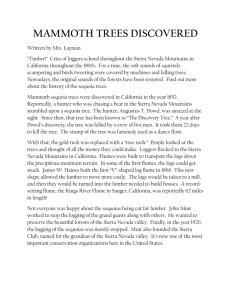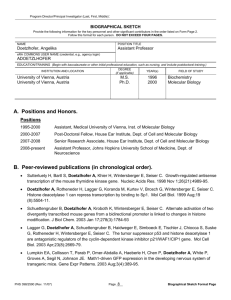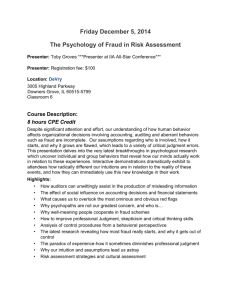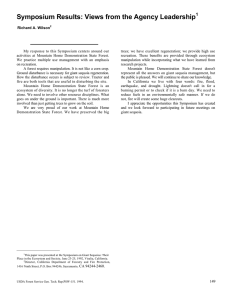Recommendations from the Sierra
advertisement
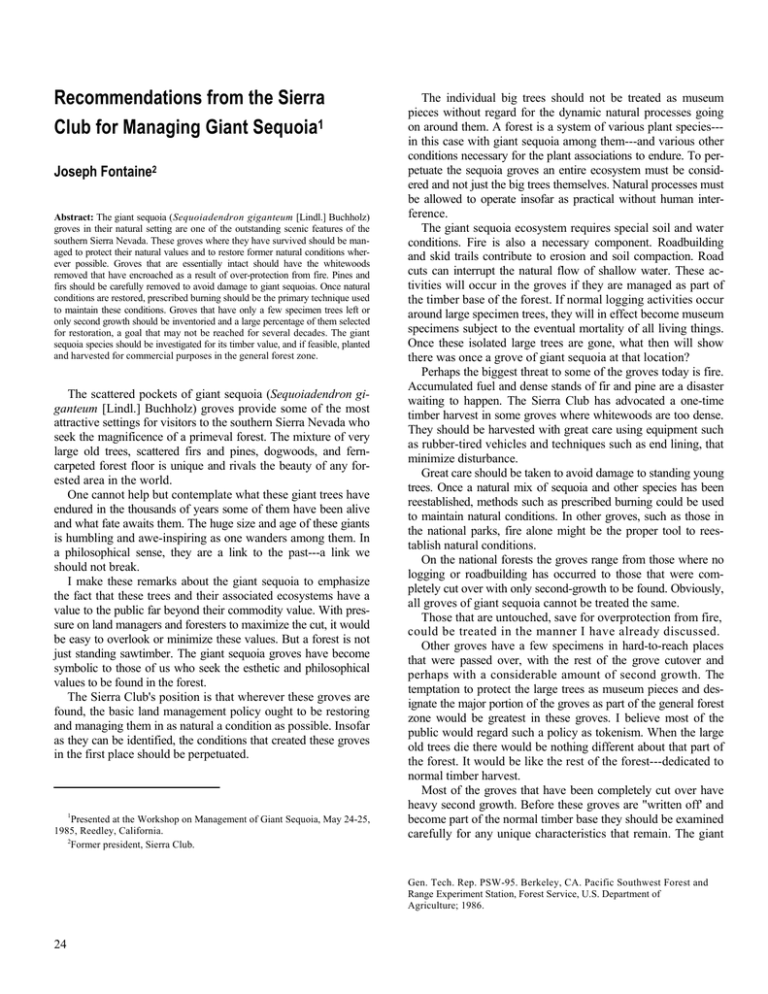
Recommendations from the Sierra Club for Managing Giant Sequoia1 Joseph Fontaine2 Abstract: The giant sequoia (Sequoiadendron giganteum [Lindl.] Buchholz) groves in their natural setting are one of the outstanding scenic features of the southern Sierra Nevada. These groves where they have survived should be managed to protect their natural values and to restore former natural conditions wher­ ever possible. Groves that are essentially intact should have the whitewoods removed that have encroached as a result of over-protection from fire. Pines and firs should be carefully removed to avoid damage to giant sequoias. Once natural conditions are restored, prescribed burning should be the primary technique used to maintain these conditions. Groves that have only a few specimen trees left or only second growth should be inventoried and a large percentage of them selected for restoration, a goal that may not be reached for several decades. The giant sequoia species should be investigated for its timber value, and if feasible, planted and harvested for commercial purposes in the general forest zone. The scattered pockets of giant sequoia (Sequoiadendron giganteum [Lindl.] Buchholz) groves provide some of the most attractive settings for visitors to the southern Sierra Nevada who seek the magnificence of a primeval forest. The mixture of very large old trees, scattered firs and pines, dogwoods, and ferncarpeted forest floor is unique and rivals the beauty of any for­ ested area in the world. One cannot help but contemplate what these giant trees have endured in the thousands of years some of them have been alive and what fate awaits them. The huge size and age of these giants is humbling and awe-inspiring as one wanders among them. In a philosophical sense, they are a link to the past---a link we should not break. I make these remarks about the giant sequoia to emphasize the fact that these trees and their associated ecosystems have a value to the public far beyond their commodity value. With pres­ sure on land managers and foresters to maximize the cut, it would be easy to overlook or minimize these values. But a forest is not just standing sawtimber. The giant sequoia groves have become symbolic to those of us who seek the esthetic and philosophical values to be found in the forest. The Sierra Club's position is that wherever these groves are found, the basic land management policy ought to be restoring and managing them in as natural a condition as possible. Insofar as they can be identified, the conditions that created these groves in the first place should be perpetuated. 1 Presented at the Workshop on Management of Giant Sequoia, May 24-25, 1985, Reedley, California. 2 Former president, Sierra Club. The individual big trees should not be treated as museum pieces without regard for the dynamic natural processes going on around them. A forest is a system of various plant species--­ in this case with giant sequoia among them---and various other conditions necessary for the plant associations to endure. To per­ petuate the sequoia groves an entire ecosystem must be consid­ ered and not just the big trees themselves. Natural processes must be allowed to operate insofar as practical without human inter­ ference. The giant sequoia ecosystem requires special soil and water conditions. Fire is also a necessary component. Roadbuilding and skid trails contribute to erosion and soil compaction. Road cuts can interrupt the natural flow of shallow water. These ac­ tivities will occur in the groves if they are managed as part of the timber base of the forest. If normal logging activities occur around large specimen trees, they will in effect become museum specimens subject to the eventual mortality of all living things. Once these isolated large trees are gone, what then will show there was once a grove of giant sequoia at that location? Perhaps the biggest threat to some of the groves today is fire. Accumulated fuel and dense stands of fir and pine are a disaster waiting to happen. The Sierra Club has advocated a one-time timber harvest in some groves where whitewoods are too dense. They should be harvested with great care using equipment such as rubber-tired vehicles and techniques such as end lining, that minimize disturbance. Great care should be taken to avoid damage to standing young trees. Once a natural mix of sequoia and other species has been reestablished, methods such as prescribed burning could be used to maintain natural conditions. In other groves, such as those in the national parks, fire alone might be the proper tool to rees­ tablish natural conditions. On the national forests the groves range from those where no logging or roadbuilding has occurred to those that were com­ pletely cut over with only second-growth to be found. Obviously, all groves of giant sequoia cannot be treated the same. Those that are untouched, save for overprotection from fire, could be treated in the manner I have already discussed. Other groves have a few specimens in hard-to-reach places that were passed over, with the rest of the grove cutover and perhaps with a considerable amount of second growth. The temptation to protect the large trees as museum pieces and des­ ignate the major portion of the groves as part of the general forest zone would be greatest in these groves. I believe most of the public would regard such a policy as tokenism. When the large old trees die there would be nothing different about that part of the forest. It would be like the rest of the forest---dedicated to normal timber harvest. Most of the groves that have been completely cut over have heavy second growth. Before these groves are "written off' and become part of the normal timber base they should be examined carefully for any unique characteristics that remain. The giant Gen. Tech. Rep. PSW-95. Berkeley, CA. Pacific Southwest Forest and Range Experiment Station, Forest Service, U.S. Department of Agriculture; 1986. 24 sequoias are only one part, albeit the most spectacular part, of specialized ecosystems that persisted for thousands of years before the advent of the saw and axe. Who among us can say with certainty that there is nothing unique or important left in these ecosystems without further study now that the largest trees are gone? Giant sequoias are fast-growing trees that are well suited to the conditions of the southern Sierra Nevada. The Sierra Club has no objection to the cultivation of the species for timber har­ vest. The characteristics of the wood make it useful for many purposes, and the harvest of cultivated giant sequoias could provide a valuable economic commodity. However, the Sierra Club does not believe the management goals of any of the untouched or partially cutover groves should include timber harvest on a permanent basis. Timber harvest might be advisable to restore natural conditions, but then should not be subsequently con­ ducted within the boundaries of the groves. The Club advocates leaving the remains of fallen trees. These giant old logs are an important part of the esthetics of the groves. The Sierra Club suggests consideration be given to making a start in restoring some of the totally cutover groves. If those trees were standing today, there would be no question about protecting them. It would be a tribute to this generation to begin the process of correcting the mistakes made when these groves were cut. Could not some of the more outstanding sites be selected and managed so that ultimately the second growth would replace the large old trees that were once there? No one alive today would live to see the outcome, but our generation would have the sat­ isfaction of setting the process in motion. I think that too often people are unable or unwilling to look beyond the pressures and concerns of daily life. These trees have been in the Sierra Nevada for probably millions of years. At one time they must have been one of the predominant species in the forest. Today they are found only in isolated pockets where they escaped the rigors of the Pleistocene. A long-term view is needed to consider what these groves represent from the past and to assure their future. There is more to trees than allowable cut and boardfeet. The giant sequoias symbolize the beauty of Sierra Nevada forests. In a way the value put on these trees and the groves where they are found is an indicator of the quality of our culture. It will be in­ teresting to see where the line is drawn between the intangible value placed upon beauty and philosophical experiences and the commodity value of the forest. How the giant sequoia groves are treated will, in a way, be a statement about the values of this generation. 25
